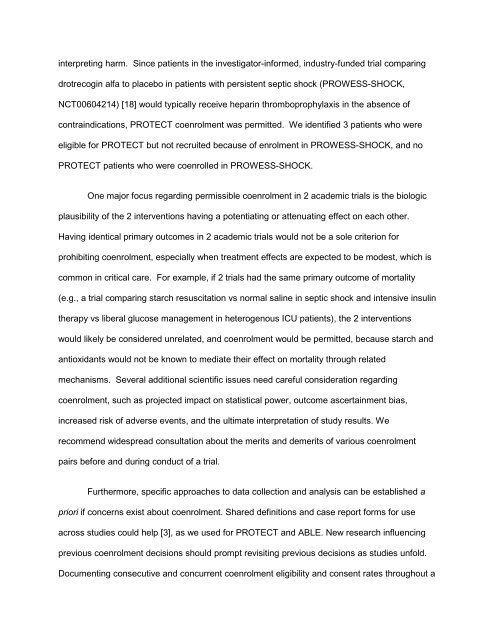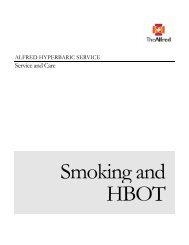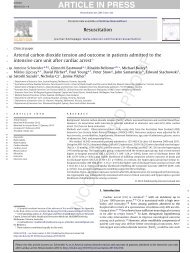Critical Care
See Full Article - Alfred Intensive Care Unit
See Full Article - Alfred Intensive Care Unit
- No tags were found...
You also want an ePaper? Increase the reach of your titles
YUMPU automatically turns print PDFs into web optimized ePapers that Google loves.
interpreting harm. Since patients in the investigator-informed, industry-funded trial comparing<br />
drotrecogin alfa to placebo in patients with persistent septic shock (PROWESS-SHOCK,<br />
NCT00604214) [18] would typically receive heparin thromboprophylaxis in the absence of<br />
contraindications, PROTECT coenrolment was permitted. We identified 3 patients who were<br />
eligible for PROTECT but not recruited because of enrolment in PROWESS-SHOCK, and no<br />
PROTECT patients who were coenrolled in PROWESS-SHOCK.<br />
One major focus regarding permissible coenrolment in 2 academic trials is the biologic<br />
plausibility of the 2 interventions having a potentiating or attenuating effect on each other.<br />
Having identical primary outcomes in 2 academic trials would not be a sole criterion for<br />
prohibiting coenrolment, especially when treatment effects are expected to be modest, which is<br />
common in critical care. For example, if 2 trials had the same primary outcome of mortality<br />
(e.g., a trial comparing starch resuscitation vs normal saline in septic shock and intensive insulin<br />
therapy vs liberal glucose management in heterogenous ICU patients), the 2 interventions<br />
would likely be considered unrelated, and coenrolment would be permitted, because starch and<br />
antioxidants would not be known to mediate their effect on mortality through related<br />
mechanisms. Several additional scientific issues need careful consideration regarding<br />
coenrolment, such as projected impact on statistical power, outcome ascertainment bias,<br />
increased risk of adverse events, and the ultimate interpretation of study results. We<br />
recommend widespread consultation about the merits and demerits of various coenrolment<br />
pairs before and during conduct of a trial.<br />
Furthermore, specific approaches to data collection and analysis can be established a<br />
priori if concerns exist about coenrolment. Shared definitions and case report forms for use<br />
across studies could help [3], as we used for PROTECT and ABLE. New research influencing<br />
previous coenrolment decisions should prompt revisiting previous decisions as studies unfold.<br />
Documenting consecutive and concurrent coenrolment eligibility and consent rates throughout a









